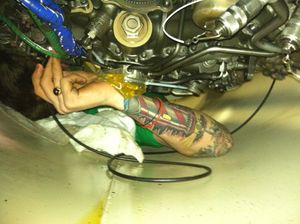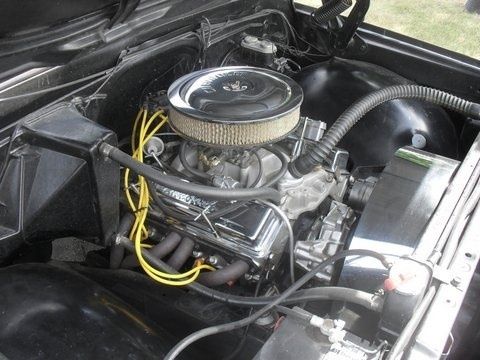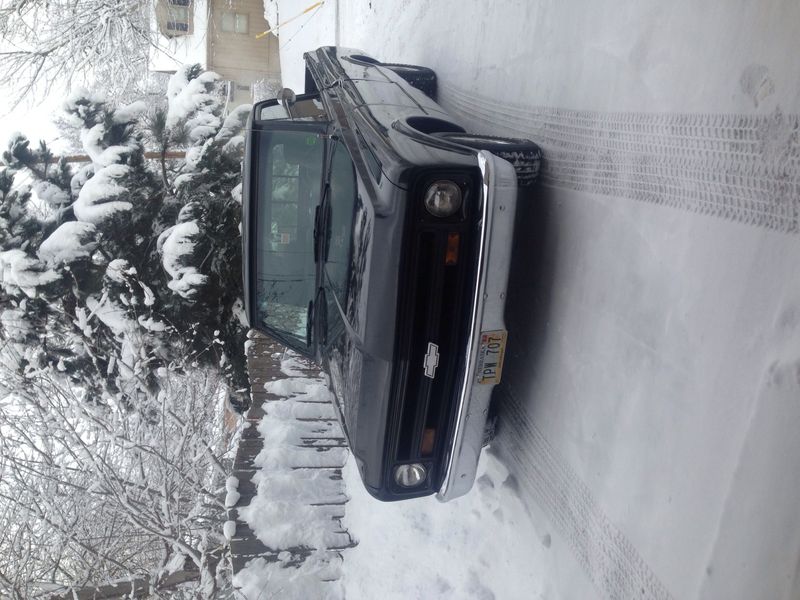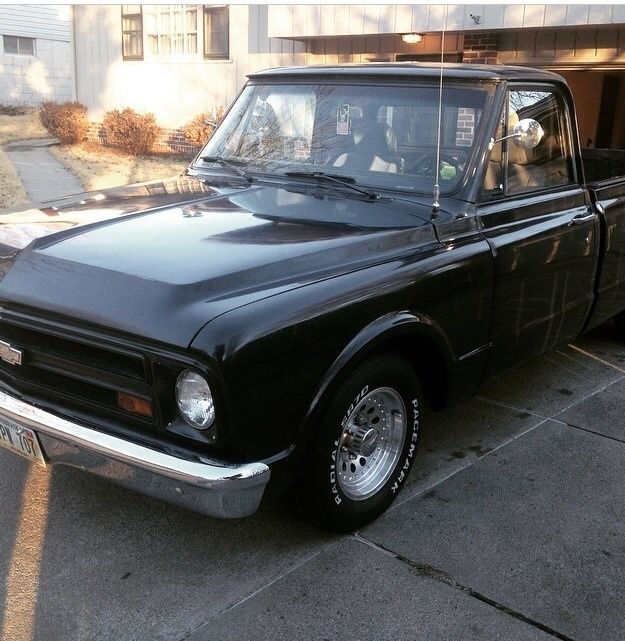Not a Mazda, prolly wrong place and a dumb question....
1029 views
5 replies
4 following

Not a Mazda, prolly wrong place and a dumb question....

somoteitbe
+1y
My mazda beater project is ongoing and has it's own plethora of issues making me question purchasing it it's good I did! Dealing with temp gauge and thermostat/over-heating issues on the mazda had my mind on that stuff thank god!
So my other ride and daily driver (until beater is good to go) is a 1967 Chevy C10 with a 383 Stroker engine approx 14k miles on it. Noticed when I hopped in it today to go to class (college) that my temp gauge doesn't work. Engine is pristine, hasn't acted funny or anything but my heater hasn't been performing like it was before. (Coolant level is good). I checked my top rad hose just for shits and giggles after warming it up for around 10 min (always keep in garage and warm up 10-15 min at idle before driving it) wasn't expecting any issues but my rad hose was solid with pressure indicating my thermostat isn't opening up. Tomorrow morning I'll go pick up a new one and new sensor for for temp gauge.
I am not leaking coolant and haven't overflowed or seen steam or anything crazy from the engine. Small oil leak in oil pan gasket I need to fix is all. My fear is overheating this engine though..it's my baby...how do I know if I have over heated it before I admirably haven't checked the temp gauge before so how long this has been going on I don't know but now I'm worried.
So is an over heated engine obvious or can it go unnoticed ? Should I check anything else for damage after I fix thermostat and temp sensor?
I know it's chevy and not mazda or bagged but with all the engine knowledge guys on here hopefully someone will know.
So my other ride and daily driver (until beater is good to go) is a 1967 Chevy C10 with a 383 Stroker engine approx 14k miles on it. Noticed when I hopped in it today to go to class (college) that my temp gauge doesn't work. Engine is pristine, hasn't acted funny or anything but my heater hasn't been performing like it was before. (Coolant level is good). I checked my top rad hose just for shits and giggles after warming it up for around 10 min (always keep in garage and warm up 10-15 min at idle before driving it) wasn't expecting any issues but my rad hose was solid with pressure indicating my thermostat isn't opening up. Tomorrow morning I'll go pick up a new one and new sensor for for temp gauge.
I am not leaking coolant and haven't overflowed or seen steam or anything crazy from the engine. Small oil leak in oil pan gasket I need to fix is all. My fear is overheating this engine though..it's my baby...how do I know if I have over heated it before I admirably haven't checked the temp gauge before so how long this has been going on I don't know but now I'm worried.
So is an over heated engine obvious or can it go unnoticed ? Should I check anything else for damage after I fix thermostat and temp sensor?
I know it's chevy and not mazda or bagged but with all the engine knowledge guys on here hopefully someone will know.




sincitylocal
+1y
The heater does not rely on the thermostat. Water circulates through the heater hoses whenever the engine runs.
Check for good circulation through the heater core, and verify the heater valve is opening.
Check for good circulation through the heater core, and verify the heater valve is opening.

somoteitbe
+1y
Good to know. I need to research it a bit more. Didnt see a heater valve anywhere on the hoses to the core though. And it turns out my radiator hose has a coil or "spring" in it which is why even now 2hrs after being shut down the rad hose is still stiff. I never even knew they had put coils in radiator hoses until just a second ago.
Still need to fix the temp gauge but I must be getting coolant to the engine so no need for new thermostat. I'll still inspect the coil inside the hose though for any corrosion just to prevent any fun that could have on my internals.
Here's the short article I just read on them.
"Original equipment molded radiator hoses often were equipped with a coil inside them. Some refer to this coil as a spring, but it isn't really a spring. Actually just a piece of thin metal rod that has been twisted, it was designed to facilitate the installation of coolant on the assembly line, and nothing more.
When the cooling system of a car is completely drained, or in the case of a brand new car under construction, never had coolant in it, there is a considerable amount of air in the passage ways. Normally, when filling up the cooling system, you start the car to circulate the coolant, displace trapped air, and then top it off. On the assembly line, this wasn't feasible, so air in the cooling system was evacuated by essentially pulling a vacuum on it. This also had the added advantage of speeding up the introduction of the coolant mixture to the cooling system as well. The coil in the lower radiator hose prevented the hose from collapsing under this higher than normal vacuum.
Once the car left the factory, the coil served no further purpose. This is why replacement hoses usually do not have a coil in them. Most cooling systems operate at 12-15 P.S.I., which is controlled by the radiator cap. This is enough pressure to allow a normally functioning cooling system to operate efficiently, yet not enough to cause collapsed hoses or leaks in seals if they're in good condition. If the lower radiator hose collapses, it is normally due to a fault somewhere else in the system, and is not necessarily indicative of a bad hose, although an old hose certainly might be susceptible to collapse due to age. Normally, if the hose is in good condition but collapsing and blocking the flow of coolant, the radiator cap is bad or there's a blockage somewhere else causing pressure to build up in the cooling system.
As vehicles with original hoses began to age, the coil would sometimes begin to corrode and deteriorate, circulating tiny pieces of metal throughout the cooling system. We'll leave it to your imagination what this did to water pumps and thermostats.
This is just one of many interesting stories about automobiles, the people who build them, and how they were built, brought to you by Automotive Mileposts."
Still need to fix the temp gauge but I must be getting coolant to the engine so no need for new thermostat. I'll still inspect the coil inside the hose though for any corrosion just to prevent any fun that could have on my internals.
Here's the short article I just read on them.
"Original equipment molded radiator hoses often were equipped with a coil inside them. Some refer to this coil as a spring, but it isn't really a spring. Actually just a piece of thin metal rod that has been twisted, it was designed to facilitate the installation of coolant on the assembly line, and nothing more.
When the cooling system of a car is completely drained, or in the case of a brand new car under construction, never had coolant in it, there is a considerable amount of air in the passage ways. Normally, when filling up the cooling system, you start the car to circulate the coolant, displace trapped air, and then top it off. On the assembly line, this wasn't feasible, so air in the cooling system was evacuated by essentially pulling a vacuum on it. This also had the added advantage of speeding up the introduction of the coolant mixture to the cooling system as well. The coil in the lower radiator hose prevented the hose from collapsing under this higher than normal vacuum.
Once the car left the factory, the coil served no further purpose. This is why replacement hoses usually do not have a coil in them. Most cooling systems operate at 12-15 P.S.I., which is controlled by the radiator cap. This is enough pressure to allow a normally functioning cooling system to operate efficiently, yet not enough to cause collapsed hoses or leaks in seals if they're in good condition. If the lower radiator hose collapses, it is normally due to a fault somewhere else in the system, and is not necessarily indicative of a bad hose, although an old hose certainly might be susceptible to collapse due to age. Normally, if the hose is in good condition but collapsing and blocking the flow of coolant, the radiator cap is bad or there's a blockage somewhere else causing pressure to build up in the cooling system.
As vehicles with original hoses began to age, the coil would sometimes begin to corrode and deteriorate, circulating tiny pieces of metal throughout the cooling system. We'll leave it to your imagination what this did to water pumps and thermostats.
This is just one of many interesting stories about automobiles, the people who build them, and how they were built, brought to you by Automotive Mileposts."

befarrer
+1y
You need to add 936 more vacuum lines to your carb to make it run as good as a Mazda lol.
As for your heater issue, I would replace the sender, or if its mechanical, replace whatever is needed, and go from there. Older cast iron engines are way more tolerant to overheating if it actually was, so I would not worry about that if it starts and runs fine.
As for your heater issue, I would replace the sender, or if its mechanical, replace whatever is needed, and go from there. Older cast iron engines are way more tolerant to overheating if it actually was, so I would not worry about that if it starts and runs fine.

sincitylocal
+1y
It's not cast iron. It's cast steel.

geterdun
+1y
You can have someone watch the temp gauge, with the key on. Ground the temp. sending unit wire momentarily, the gauge should peg out HOT (may take slightly longer grounding time), if not, poor connection (between the sending unit and the 12 volt source) or bad gauge.
Disconnect the battery, turn the key on, use ohmmeter at temp sending unit wire, ground the other ohmmeter lead, which is positive.negative connected does not matter when doing this.
Cast iron block, like most, cast steel crank.
Disconnect the battery, turn the key on, use ohmmeter at temp sending unit wire, ground the other ohmmeter lead, which is positive.negative connected does not matter when doing this.
Cast iron block, like most, cast steel crank.
Related Discussions in Mazda Engine General
Thread
Posts
Last Post

